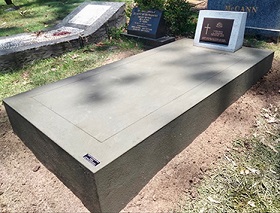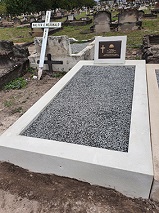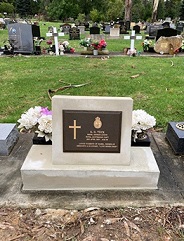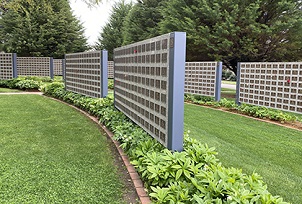Official commemoration
Official commemoration recognises the service of eligible veterans or serving members after their death. This takes the form of a personalised, physical marker, such as a plaque. The marker can be at a site they or their family have chosen.
On this page
What types of commemoration are there
The Office of Australian War Graves (OAWG) provides commemorations in:
- a cemetery
- a crematorium
- an OAWG Garden of Remembrance.
We will pay for the commemoration and the upkeep of that commemoration for eligible veterans.
To make sure we commemorate all veterans equally, all commemorations that we provide will:
- be uniform in appearance if they are the same type
- remain the property of the OAWG
- not be changed in any way.
Monumental commemorations in a general cemetery


Before we can provide an official commemoration, the grave must be completely bare of any and all monumental work, such as:
- kerbing
- plaques
- grave markers
- other adornments or infrastructure.
In a cemetery other than a lawn cemetery, we provide a standard commemoration that consists of:
- rendered concrete kerbing
- infill
- a rendered concrete grave marker
- a bronze plaque.
Commemorations in a lawn cemetery

We will provide a bronze plaque for placement on the grave. Depending on cemetery regulations, we may also provide a plinth or other base.
Bronze plaques provided in a cemetery are inscribed with a veteran's:
- service emblem
- initials and surname
- service details
- date of death
- age.
You will also have the option to have either or both:
- a personal message
- a religious emblem.
Commemoration in a crematorium
We will provide an official bronze plaque:
- sealed on a wall
- placed within a garden bed.
If the ashes have been scattered or the family decides to keep them, we will provide a Garden of Remembrance plaque.
Crematorium plaques don't contain personal messages or religious emblems.
Commemoration in a Garden of Remembrance

We have established Gardens of Remembrance in each state and territory capital city, as well as in Launceston and Townsville. Most are located near a major war cemetery.
When we are either unable to or not asked to provide an official commemoration in a cemetery or crematorium, we can provide a Garden of Remembrance plaque. This is a bronze plaque placed on a wall in a garden setting. These plaques do not contain a personal message or any religious emblems.
If you live a long distance from a Garden of Remembrance, you can ask us for a photograph. We will provide one free of charge.
Back to topWho is eligible
We will provide an official commemoration for all veterans whose death has been accepted by the Department of Veterans’ Affairs (DVA) as related to their war service.
We will also provide an official commemoration for veterans who were:
- ADF members who died during war, peacekeeping activities, or certain other operations, including warlike and non-warlike service
- multiple amputees as defined in Section 27.1 of the Veterans' Entitlements Act 1986 (VEA) on maximum pension rate where service in a war or conflict has been proven
- ex-prisoners of war
- a Victoria Cross recipient.
Official commemoration is also available to veterans receiving one of the following payments when they died:
- Disability Compensation Payment
- extreme disablement adjustment (EDA)
- temporary special rate pension (TSR or T&TI)
- intermediate rate pension (INT).
If you have a question about eligibility, please contact us.
Back to topWhat steps are involved
There are 4 steps.
Step 1
Let us know about a veteran’s death. You can do this by calling us on 1800 VETERAN (1800 838 372), visiting us in a VAN office or by using the General enquiry form.
Step 2
DVA will assess if the veteran is eligible for an official commemoration. If they are, they will let us and you know.
Step 3
We will contact the veteran’s next of kin and send them a form asking about the type of commemoration they would like.
Step 4
We will then arrange for the commemoration to be placed.
If a veteran is not eligible
Where a veteran is found not to be automatically eligible for an official commemoration, you can ask us to investigate. You can:
- download the Request for a cause of death to be assessed as war related form and submit it via email or post
- email us at compensation.claims@dva.gov.au
- write to us at Deputy Commissioner, Department of Veterans' Affairs, GPO Box 9998, Brisbane QLD 4001.
How long does it take to arrange
The time it will take to arrange a commemoration will depend on the type and location of the commemoration.
On average, commemorations are completed within the following time frames:
- Full grave cover: 6 to 8 months
- Lawn cemetery or crematorium: 4 to 6 months
- Garden of Remembrance: 3 to 5 months
This is from the date we receive your completed form.
Full grave covers may take longer because of individual cemetery regulations or because the cemetery is remote.
Back to topWhat about second burials
The grave of an eligible veteran in a cemetery may be reopened for further burials, such as a partner or family member.
Where we have provided a full grave cover, we will restore the grave to its original condition. The family may then place a plaque for the additional burial at their own cost in the centre or towards the foot of the grave.
The cemetery is responsible for the restoration of the grave in lawn areas. An additional plaque may be placed if the lawn cemetery authorities permit it. Please contact us to discuss your options.
Back to topWhat is tenure
A tenure for a grave plot or ashes placement is like a lease. In some states and territories, cemeteries and crematoriums limit the length of the tenure at the time a plot or niche is purchased. This means if the tenure can’t be extended, the site may be reclaimed.
It is the family or estate's responsibility to extend the tenure of these sites when it is due.
If the tenure is not extended and the site is reclaimed, the cemetery or crematorium can request that the official commemoration be moved. If this happens, the official commemoration provided will be transferred to an OAWG Garden of Remembrance.
Back to topWho maintains the commemoration
We do. As well as maintaining official commemorations, we care for:
- 72 war cemeteries in Australia
- 3 war cemeteries in Papua New Guinea
- individual war graves in civil cemeteries.
Maintenance of official commemorations is done as often as resources permit. This is usually once a year. In remote areas, maintenance takes place as frequently as possible.
Delays to maintenance may take place because of bad weather or limited resources.
Back to topWhere can you get further support
You can call us on 1800 VETERAN (1800 838 372) to talk about your own eligibility, the eligibility of a family member or to tell us a death has occurred.
You can also email us at wargraves@dva.gov.au if you have specific questions about the types of commemorations available.
Planning Ahead – A guide to putting your affairs in order
Our Planning Ahead Booklet provides detailed advice on preparing for and managing bereavement. Find out about legal and financial issues, such as:
- wills
- setting up a power of attorney
- guardianship arrangements.
Open Arms – Veterans’ & Families Counselling
Open Arms offers free and confidential counselling services to current and former ADF personnel and their family members. Visit their website at Open Arms or call them on 1800 011 046 to find out more.
Advocates and ex-service organisations (ESOs)
Advocates and ESOs can help you to sort through what needs to be done after a family member dies. They can help you to apply for pensions and payments.
Non-DVA assistance
There are a number of independent and government sponsored helplines available:
- Beyond Blue, call 1300 22 4636
- Lifeline, call 13 11 14
- MensLine, call 1300 78 99 78
- QLife, call 1800 184 527.
We cannot take responsibility for any information provided by these organisations.
Back to top